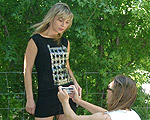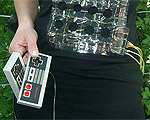Media
Forum Program
I.
Competition program
II.
Presentation program
The Rape of the Sabine Women
Eve Sussman’s film, USA, 2006, 80’00’’
Shot in Berlin, in Athens and on the Greek island of Hydra,
the movie is an avant-garde costume drama in five acts. Its
story is a variation on the ancient myth of the Sabine women,
who after being abducted, raped and forced into marriage by
Roman warriors, wade into a pitched battle between their
husbands and their Sabine relatives to secure peace and the
future of Western civilization.
The movie’s heroics and pageantry are inspired by the Sabine
paintings of Poussin, Rubens and David — especially David’s
“Intervention of the Sabine Women” of 1799. But Ms.
Sussman’s “Sabine Women” is set in the endlessly stylish,
initially optimistic 1960s.
Despite their utopian veneer, the 1960s were arguably the
beginning of the situation in which the world now finds
itself. So it is not surprising that in Ms. Sussman’s
version of the Sabine myth, everyone simply fights to the
death, albeit in a stagey, slow-motion, painterly way. Ms.
Sussman has recast the birth of a society as destruction.
Artistically, the film is an intriguing summation of the
worldliness that began to enrich art in the late 1970s.
While using Classical, Neo-Classical and International Style
elements, it also draws expertly on 30 years of avant-garde
appropriation and formalist self-reference. Its scenes may
recall the cosmopolitan performances of Robert Wilson and Ms.
Bausch; the photo-based art of Cindy Sherman, Richard Prince,
Laurie Simmons, Robert Longo and Philip-Lorca Dicorcia; and
the historicizing lushness of Neo-Expressionist painters
like Julian Schnabel and David Salle, as well as the
filmmakersculptor Matthew Barney.
While “89 Seconds at Alcazar” grew from a projected
89-second time frame to fill 10minutes with fly-on-the-wall
tension, the 80-minute “Sabine Women” stretches its beauty
before us with overindulged, seductive, feline opulence.
Ms. Sussman has come a long way from her solo debut at
the Bronwyn Keenan Gallery in SoHo in 1997, where she showed
funky, live-feed video broadcasts of pigeons roosting in the
building’s airshaft. By 2004, she had replaced Discovery
Channel Post- Minimalism with Masterpiece Theater grandeur
in “89 Seconds at Alcazar,” a mesmerizing 10-minute video
projection that wended its way through what appeared to be a
modeling session for Velázquez’s elaborate painting “Las
Meninas.” Fraught with whispered exchanges, rustling silks
and discreet gestures, this piece became the breakout hit of
the 2004 Whitney Biennial.
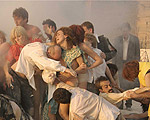
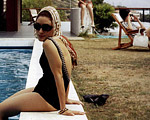
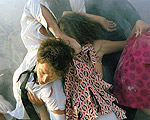
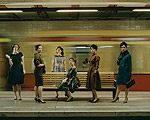
Performing myself
Vito Acconci Retrospective program
Curated by Nina Zaretskaya
Acconci’s early performances—including Claim (1971) and
Seedbed (1972)—were extremely controversial, transgressing
assumed boundaries between public and private space, and
between audience and performer. Positioning his own body as
the simultaneous subject and object of the work, Acconci’s
early video tapes took advantage of the medium’s
self-reflexive potential in mediating his own and the
viewer’s attention. Consistently exploring the dynamics of
intimacy, trust, and power, the focus of Acconci’s projects
gradually moved from his physical body (Conversions, 1971)
toward the psychology of interpersonal transactions (Pryings,
1971), and later, to the cultural and political implications
of the performative space he set up for the camera (The Red
Tapes, 1976). Since the late ‘70s, Acconci has designed
architectural and installation works for public spaces.
Vito Acconci Retrospective program:
-
Three Frame Studies, 1969, 10’58’’
-
Two Cover Studies, 1970, 7’46’’
-
Three Adaptation Studies, 1970, 8’05’’
-
Openings, 1970, 14’00’’
-
Pryings, 1971, 17’10’’
-
Conversions, 1971, 65’30’’
Born 1940 Bronx, New York, USA. The artist
lives and works in Brooklyn, New York. Vito Acconci is a key
late twentieth-century pioneer of performance, video,
installation and the exploration of architectural space.
Initially a poet, Acconci began making Conceptual art in the
late 1960s.
A poet of the New York school in the early- and mid-1960s,
Vito Acconci moved toward performance, sound, and video work
by the end of the decade. Acconci changed direction in order
to “define [his] body in space, find a ground for [him]self,
an alternate ground for the page ground [he] had as a poet.”
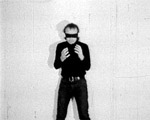

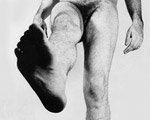
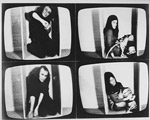
«The man who
traveled around the world to make a sculpture»
Erwin Wurm video retrospective
Curated by Konstantin Bokhorov
Erwin Wurm’s video works belong to an unusual variety of the
genre. They are derived from sculpture, though not the
classical, monumental and heroic as it is seen in the mass
consciousness, but the contemporary, deconstructing its own
false bathos. Wurm invented one-minute sculptures that are
actually performances into which his characters are snatched
for art from the stream of life at the most strange and
absurd moments.
Video is one of such media that allow their capture and
monumentalization. Wurm’s characters act bizarre – one puts
on the entire stock of a second hand clothes shop in Fabio
getting dressed, 1992. Another is aroused by the
radiator-generated heat (Heating, 2000), yet another gets
married to a house he likes (True Love, 2005). A special,
psychoanalytical sense of humor is inherent to Wurm’s vision.
By practicing it in a society where Freudian slips are
sometimes more meaningful than official news reports he
gradually reveals its own psychological condition.
Content:
-
«Und» (A-B-C, B-C-A oder C-A-B), 1990, 16’36’’
-
«Still 1», 1990, 3’54’’
-
«13 Pullover», 1991, 9’26’’
-
«59 Positions», 1992, 20’00’’
-
«Shopping», 1995/96, 26’12’’
-
«Memory», 1994/00, 10’07’’
-
«Flight Simulator», 1998, 8’24’’
-
«Heating», 2000, 3’09’’
-
«I Love My Time, I Dont Like My Time», 2003, 8’40’’
-
«Blow Job I», 2007, 5’43’’
Erwin Wurm, 1954. An Austrian sculptor, widely acknowledged both in his homeland and abroad for his innovative approach to traditional media. Exhibited at the Lyons Biennale, Venice Biennale, Seville Biennale and Taipei Biennale. His one-man exhibitions were organized by the Drawing Center, NY, Palais de Tokyo, Paris, Kiasma, Helsinki, Contemporary Arts Center Cincinnati, MUMOK Museum, Vienna, Deichtorhallen, Hamburg and others. Teaches at the Academy of Fine Arts, Vienna. Lives and works in Vienna and New York.
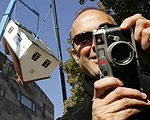
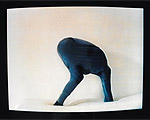
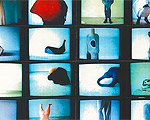

Program «Open video»
Curated by Konstantin Bokhorov
Modern-shamanism
Contemporary artist is armed with the optic of new media
that allows him to look deep in the subconsciosness of
cultures and traditions. Symbols and energies reflected on
the mirroring surface of his monitor are in his unlimited
will. The tendency to manipulate them is common for
modernism and shamanism.
-
Alexander Podoprigov, Russia
Sight of witch, 2002-2005, 10'00'' -
Teimur Daimi, Azerbaijan
Geo-art, 2005, 6'00'' -
Myriam Thyes, Luxemburg
Virtual Therapy, 2006, 9'54'' -
Elena Kambina, Russia
Untouchable Territory, 2006, 8'20'' -
Eliza Fernbach, UK
Amaze Labyrinth, 2005-2006, 4'30'' -
Alexandr Nicolaev, Russia
Prayer, 2007, 5'05'' -
Pavel Batalov, Russia
Dancers, 2007, 4'07'' -
Mary Lagerquist, Sweden
When it Blows, 2006, 2'00'' -
Vladimir Logutov, Russia,
Cubik Rubika, 2007, 1'00'' -
Yury Vasiliev, Russia
Cover, 2007, 4'30'' -
Ane Lan, Norway
Vesta, 2006, 6'13'' -
Elvira Todaro-Haakon, Faste-Massimo Bergamasco, Italy
The hand dance, 2007, 7'15'' -
Tassos Langis, Greece
Spineline, 2007, 4'49'' -
Stuart Pound, UK
Reverberation in time, 2006, 2'18'' -
Dovg Fishbone, USA/UK
Everybody loves a winner, 2004, 8'30'' -
Anky van der Heyden, The Netherlands
Reverse eleven, 2007 -
Group «Zasada Tsetkin»
Mirrow shivas, 2002, 3'21'' -
Jim Finn, USA
The Small Little Teeth of America / The Tiny Dentures of Imperialism, 5'00''
Psyho-domesticity
The trend psyho-domesticity is set through the search of
the new realism. That is great cultural tradition of
modernism in cinema and visual arts. Media and the sphere of
subconsciousness find in it common points and through them
cerebral system receives technological expansion in the
outside, in pure matter and physical processes which
explains the potentiality of this trend.
-
Dionysius Artifex (Denis), Russia
Scalae, 2007, 8'13'' -
Alexandr Trotsak, Russia
Sitting behind the window, 2007, 6'13'' -
Anton Litvin, Russia
From Moscow with a night, 2007, 4'50'' -
Natalia Poloka, Russia
«1» (one), 2007, 1'00'' -
Vladimir Gorohov, Elena Hairulina, Russia
Moon night, 2007, 4'07'' -
Nastia Tarasova, Russia
Old country house, 2005, 10'00'' -
Halina Kliem, Germany
Real World (still toddling), 2006, 3'04'' -
Marina Chernikova, Holland
Love puzzle - 3, 2006 , 3'00'' -
Sofia Goscinski, Austria
Hot Dog, 2000, 2'43'' -
Sergey Jelestsov, Russia
Fandomat, 2007, 22'14''
Techno-alarm
This fact could seem strange but technologies possessing
enormous potentiality to affect consciousness rarely are
able to cause enjoyment. Agitation, euphoria, hallucination,
everything that is a consequence of a pure mechanical action,
this is a positive sphere of psychological contact with
technologies. Unconsciously the art of media expresses this
in a particular sensibility. The given screening proposes
for it its own definition — alarm
sensibility (reaction to technologies).
-
Pierre-Yues Cruaud, France
Traces, 2005, 6'00'' -
Arianna Olthaar
TNO-Rijswijk, 2006, 5'11'' -
Marina Fomenko, Russia
Palimpsest, 2007, 2'10'' -
Michael Brynntrup, Germany
Face it, 2007, 15'00'' -
Alexey Kuripko, Russia
Virus hospitality, 2007, 4'04'' -
Dmitriy Bulatov, Danila Akimov, Russia
8-th day, 2007, 6'10'' -
Patrik K.-H., Russia
Animations, 2007 -
Nick Deamer, USA
Compound Memory, 5'28'' -
Oksana Cheplik, Ukrain
Chernobyl Fary tale, 2006, 9'10'' -
Alexandra Dementieva, Russia, Belgia
Limited spaces 1 and 2, 2006, 10'00''
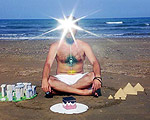
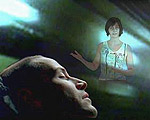
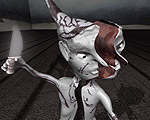
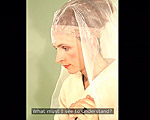
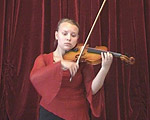
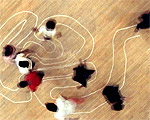
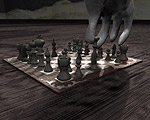
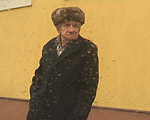
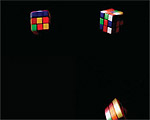

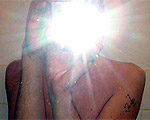
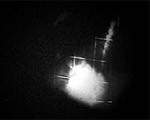
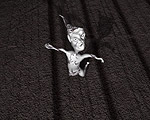

III. Round tables, panel discussions, seminars, workshops
Super-Embodiment of Woman-Artist in Media Art
Round table
Question of Embodiment and in particular – Nudity and the
Nude – have become key issues in contemporary art, theory
and politics. Women artists face what Foucault called
‘hysteriarization of female body’, while men artists face an
issue of ‘absent male body’ (Kelly Oliver) and respond to it
with various strategies. One might argue that both Western
and Eastern European women artists have exhibited ‘too much
body’, and to a certain extent find it difficult to leave
“body” behind. However, we rarely discuss what impact
socialist gender policies and practices have had on this
process within aesthetics. If performance art leaves us with
legacy of ‘too much body’ — ‘super-embodiment’, — one
wonders of it morphs into (new) media art as question of
‘machine’ / ‘cyborg’ embodiment and its identity. Media art
by Boryana Dragoeva Rossa (Bulgaria), Erika Katalina Pasztor
(Hungary), and Elena Kovylina (Germany / Russia) will serve
as case studies, alternative to and through
‘super-embodiment’ in contemporary art.
Participants: Nina Czegledy (Canada, Hungary), Margaret
Jahrmann (Austria, Switzerland), Irina Aristarkhova (Russia),
and Elena Kovylina (Germany, Russia).
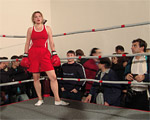
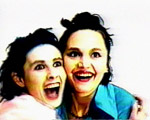
Cultural cooperation online in Europe: using online
technologies to enchance artistic and cultural cooperation.
Workshop by Angela Plohman (Netherlands)
Online spaces (community groups, open forums, wikis, blogs,
etc.) offer possibilities for artists and cultural
practitioners to find freedom to share and exchange, outside
of institutional settings, to engage in dialogue, and to
develop and test ideas. Contemporary artists are certainly
experienced in exploring the potential of new technologies
and new media, however there are few visible links and
collaborations between new media (art) communities and the
rest of the artistic and cultural networks active more
offline. It seems clear that the more traditional cultural
infrastructure and the way we manage cultural content online
often remain far from each other. Why is this the case and
what could be done to better understand and use more
efficiently the power of new technologies to improve
cross-border and cross-disciplinary collaboration in Europe?
Angela Plohman has worked for the last 8 years in the
field of art and technology. From 1998-2001, she held the
position of Program Officer at the Daniel Langlois
Foundation for Art, Science and Technology in Montreal. Over
the last 5 years she has coordinated a two-year Culture
2000-funded project called exStream, which focused on the
artistic use and development of open source streaming tools;
worked as a project manager for the Blender Foundation; was
the Coordinating Director of the Inter-Society for the
Electronic Arts; produced and researched for the V2_Lab in
Rotterdam; and has written and published numerous texts both
online and in print publications. Angela is currently
Content Developer at
LabforCulture, a
partner initiative of the European Cultural Foundation,
where she has worked since October 2005.
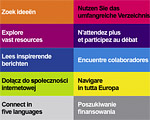

Play: research and development in the interdisciplinary
field from an art perspective.
Lecture by Anne Nigten (Netherlands)
Anne Nigten (manager V2_Lab, Rotterdam, the Netherlands)
gives a practice-based presentation about electronic art
projects and experiments grouped around the PLAY theme. In
this presentation Nigten draws from music and performing
arts from there she moves towards early interactive
electronic art and ends her talk with electronic art works
dealing with today’s interpretation of play. Her
presentation is illustrated with interactive electronic art
works, which brings along a gamut of PLAY elements, such as
co-creation or DIY aspects and improvisation. Nigten
concludes her presentation with several striking parallels
between playful interactive art, serious gaming and mixed
reality games. After the presentation you will be invited to
participate in a discussion around the PLAY theme with other
members of the audience and Anne Nigten.
Anne Nigten (PhD) is the manager of V2_Lab, the aRt&D
department of V2_, Institute for the Unstable Media in
Rotterdam, the Netherlands. Anne is lecturing on research
and development in the interdisciplinary field from an art
perspective. She is advisor for several media art and
science initiatives in Europe, board member of ISEA and
member of the board of directors of The Public-gallery (UK).
She completed her PhD at the University of the Arts London (UK),
and frequently publishes papers on art, engineering and (computer)
science collaboration and software development. Before her
current position at V2_ she has been working as an
independent media artist, and simultaneously fulfilled
several management jobs for the media art sector in the
Netherlands.
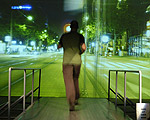

The third modern — denuding the media.
The technobiological art work.
Lecture by Dmitry Bulatov (Russia)
The revolution in biology that gives birth by means of
biomedical technologies such as genetical engineering,
implantology, stem cells engineering and cloning is the
flexibility of the homo sapiens species itself. The
evolutionary potential inherent to this trend provides a gap
between contemporary human condition and some of man’s
primary biological characteristics as well as acquisition of
non—human characteristics and results in changes to the very
anthropomorphic image of the civilization. In contemporary
art works produced by biomedical and information
technologies appear as models. An exemplary project of this
kind is Extra Far by an Australian artist Stelark —
implanting a third ear grown from artist’s own stem cells.
Dmitry Bulatov (Kaliningrad, Russia) — artist, researcher,
art theorist. Organized a series of exhibitions and
publishing projects on various aspects of art and high-tech
interrelations (sci-art, robotech, genetic engineering,
nanotech). Published more than 30 papers on contemporary art
both in Russia and abroad as well as monographs and
anthologies. Exhibitions: Ars Electronica («Radiotopia»,
Linz, 2002), 50 Venice Biennial («Brain Academy Apartment»,
2003) and many others. Awards: Priznanie, 1998, Minor Booker
Prize short list, 2000. Since 1998 — curator at the
Kaliningrad State centre for Contemporary art.

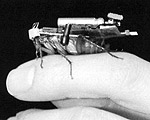
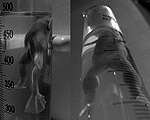
IV. Multimedia shows
Pong Dress: READY PLAYED?
Interactive performance by Margarete
Jahrmann
The little black dress as erotic real playground for pong?
When marguerite Charmante wears her new neck top and offers
the game controllers, attached at her lap height. We cannot
resist being seduced to play! a charming seduction for
playing, since it is possible to play the stylish plastic
LED-grid, which covers chest and stomach area of the dress.
Pong is the name of the game: hit the dot back and forth
with two sticks — this time all new on a 3D playing field,
that is moving, chatting and laughing. Apparently, Valie
Export’s «Tap and Touch Cinema» is sur-facing as the obvious
analogue pop-art-cultural-reference to Marguerite Charmantes
«Ludic Pong Dress». Whilst the games at display vary to some
extend, the symbiotic dedication and obsession for the
playground’s finesse remain the same. Both, the privileged
active players and the countless inter passive observers,
will be sucked into the game.
Margarete Jahrmann — born in
Vienna, Austria, lives and works in Zurich, Switzerland. As
artist Jahrmann is the conceiver of ludistics and Ludic
Sociey founding member. With her arts work she introduces
new genres beyond game art, as conceptual setups for
optional publication formats, on printed circuit boards and
the Ludic Society magazines. Her actual main interest lies
in Game Fashion and Real Play. She focuses on the
investigation on game systems as constraints and toy objects
as deliberating ostensible uselessness. As performer in
RFID-tagging, city plays and neopataphysist writings she
plays with gamefigures and new bachelor machines. Jahrmann
received 2003 a distinction in interactive arts at Prix Ars
Electronica with the anti-war shooter nybble-engine toolz
and was awarded a distinction at the software art award of
in 2004 together with Max Moswitzer. In 2007 she perfromed
at the DEAF Festival Rotterdam with a mobile RFID tagging
play and at the Socieal Hacking Event Plymouth, UK. She is
professor for ludology and game conceptions at the game
design department of university of arts and design Zurich.
